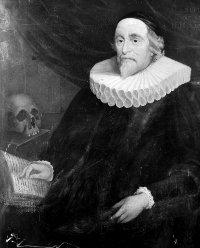By Dr. 布莱恩T. 凯利(88)
Note: The following remarks are adapted from Dean 布莱恩T. Kelly’s report to the Board of Governors at its May 15, 2015, meeting. 它们是人类的一部分 正在进行的一系列会谈 about why the College includes certain authors in its curriculum.
历史学家认为威廉·哈维是科学革命的关键人物之一, which lasted from about the time of Copernicus until Newton, roughly the 16th through the early 18th centuries. 他BG电子血液在全身循环的发现是医学史上最重要的发现之一. He was a contemporary of Galileo, 弗朗西斯•培根, 笛卡尔, 霍布斯, 开普勒, 吉尔伯特, 和博伊尔, and knew many of them personally. 事实上, 他是伽利略在帕多瓦大学的同学,也是培根的私人医生.
Harvey was a liberally educated and well trained doctor. 他深入研究经典,并获得了剑桥大学和帕多瓦大学的医学学位. He began a very successful medical practice in London, 1615年,他还获得了卢姆莱人体解剖学讲师的荣誉职位. 1618年,他被任命为詹姆斯一世的御医,后来又担任查理一世的御医. 他甚至在英国内战的边山战役中帮助拯救了王室. He kept copious notes on his anatomical observations through dissection and experiment. In 1628 he published a relatively short book called On the Motion of the Heart and Blood in Animals. There was significant resistance to his claims in the medical community, 甚至有人说,他的事业受到了影响,因为他的名誉立即受到了玷污. 但这篇论文使他成为医学史上最伟大的人物之一.
In our freshman Natural Science tutorial we read this book along with his later Anatomical 练习 on the Generation of Animals.
亚里士多德医生
因为他与这次科学发展的历史性爆炸密切相关, 哈维经常被誉为一个现代人,他帮助世界摆脱了对经院哲学和基督教迷信的束缚. 事实上, 你可以通过看他BG电子心脏和血液运动的作品的版本来了解这一点. If you look inside you will notice that it is put out by Prometheus Books, a company committed to publishing in the areas of “atheism, 人文主义, 批判性思维.” But on closer inspection this view cannot stand.
Take 例如 the following passage from his 练习我们承认上帝, the supreme and omnipotent creator, to be present in the production of all animals, 为了指出, 可以说, with a finger to his existence in his works” (Exercise 54). 通过照亮大自然的杰作,哈维认为自己照亮了上帝的杰作.
尽管现代科学倾向于与亚里士多德和经院哲学家形成鲜明对比, Harvey certainly saw himself as a scientist in the traditional mold of Aristotle. 12世纪和13世纪,亚里士多德的论文重新引入西方世界,引起了人们对自然科学的极大兴趣. Yet even though Aristotle was one of history’s greatest natural philosophers, he was still subject to the limitations of his time and observations. Scientists in Harvey’s time had tools that Aristotle did not, e.g.伽利略的望远镜. So while Aristotle laid out very sound general conclusions in natural philosophy, many of his more particular conclusions were highly speculative and even mistaken. 我们现在知道, 例如, that there are more than four basic elements, and that bodies of different weight fall at practically the same speed.
亚里士多德的天才和由此产生的权威的部分困难在于,较小的头脑盲目地追随他和他的结论. This was not true of Harvey. Although many of his scientific confreres simply rejected Aristotle, Harvey studied him carefully as a master, accepting his general principles and methodology. 他没那么傻, 然而, 认为亚里士多德在得出特定结论时不会出错. This is very clear from the beginning of Harvey’s Anatomical 练习 on the Generation of Animals. 他做的第一件事就是拒绝亚里士多德的结论,认为它是“错误和草率的”.” But this is quickly followed by a careful treatment of the “one road to science,” which draws heavily on Aristotle’s logical and physical works. 哈维说,我们必须“从已知的事物到未知的事物……而共相主要是我们所知道的。, science springing by reasonings from universals to particulars; still the comprehension of universals by the understanding is based upon the perception of individual things by the senses.”
对哈维来说, 至于亚里士多德, 真正的自然科学家必须准备进行抽象的论证,但必须始终把抽象植根于彻底而仔细的观察中. I highly recommend an excellent treatment of this question in an article by Dr. Herbert Ratner that can be found in the third volume of 阿奎那述评.
心里话
让我来简要介绍一下哈维BG电子心脏导致血液循环的部分论点. The most influential view that he had to contend with was Galen’s notion that the liver and the heart both sent blood forth to the various parts of the body; the heart by way of the arteries, and the liver by way of the veins, where the blood was completely consumed. There was no notion of blood returning to the heart; it merely went forth and was used up.
现在哈维争辩道, through many kinds of arguments and experiments, that this could not be an accurate account. 其中最引人注目的是他的观察,表明血管不是偶尔充满血液,而是不断充满血液. 他进一步观察并测量了当动脉被切断时脉搏中流出的血液量. 由此,他可以保守地计算出,每天有540磅的血液通过动脉. 如果盖伦的说法是正确的,那么人体每天必须产生和消耗540磅的血液. 你能想象如果我们每天需要生产540磅的新鲜血液,我们需要消耗多少食物和饮料吗? 另一方面, if the blood is moving in a circle, 然后心脏在一天内不断地泵出同样的血液.
(Here I am reminded of the Confederate General John B. 马格鲁德, 是谁让麦克莱伦将军把他的部队绕成一圈开进营地,从而使他陷入了漫长而代价高昂的拖延. He marched them in and then snuck them out and marched them back in again.)
By means of ligatures Harvey was able stop the flow of blood in the arm. 通过阻塞然后释放动脉,他能够看到动脉将血液输送到手臂的末端. 通过阻塞和释放静脉,他能够证明静脉将血液从四肢输送回心脏. All of this gives a concrete sense of the circle or circuit of the blood’s motion. Harvey summarizes at the end of chapter eight, “The artery is the vessel which carries the blood from the heart to the body at large, the vein of the present day bringing it back from the general system to the heart; the former is the conduit from, 后者的通道到, the heart; the latter contains the cruder, 疲惫的血液, rendered unfit for nutrition; the former transmits the digested, 完美的, 特别的营养液.”
In teaching this portion of the natural sciences, we try to imitate Harvey’s approach by dissecting a sheep’s heart, which is large enough to show forth the principal chambers, 船只, 还有心脏的瓣膜. Though it is not part of the syllabus, 学生们总是自发地找一个志愿者用一个临时的绷带来做血液流动实验. Usually one of the young men will remove his belt and put it around a classmate’s arm. 哈维对我们来说特别有趣,因为他展示了自然科学中永恒哲学的丰硕成果.








